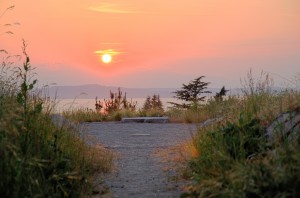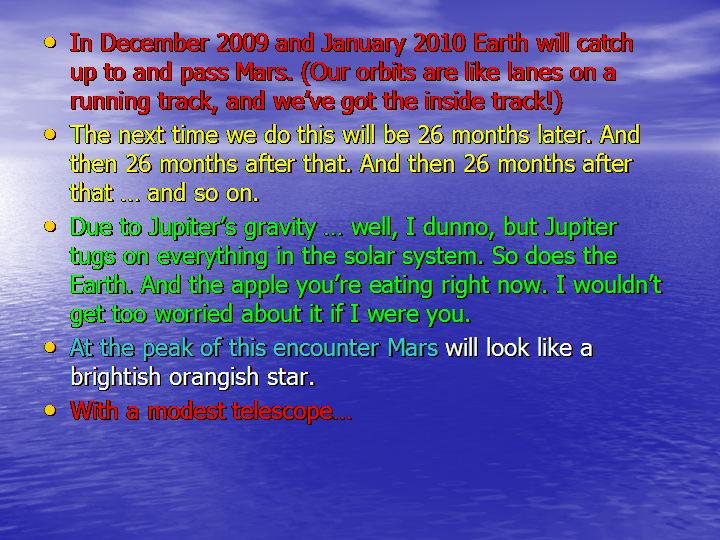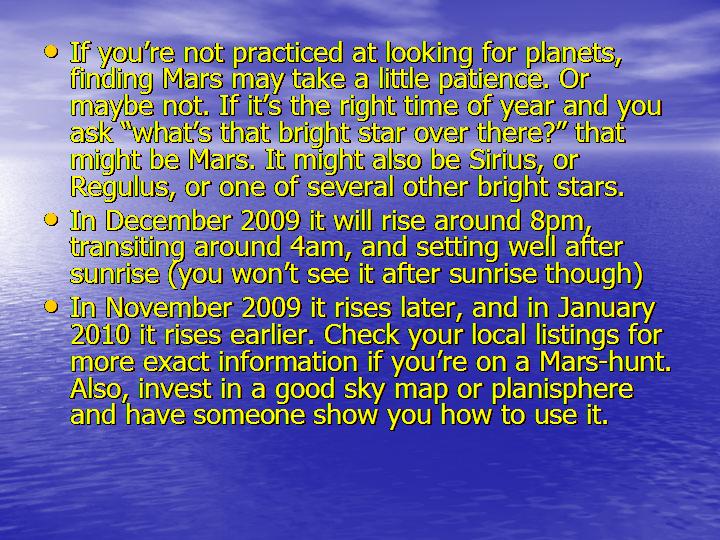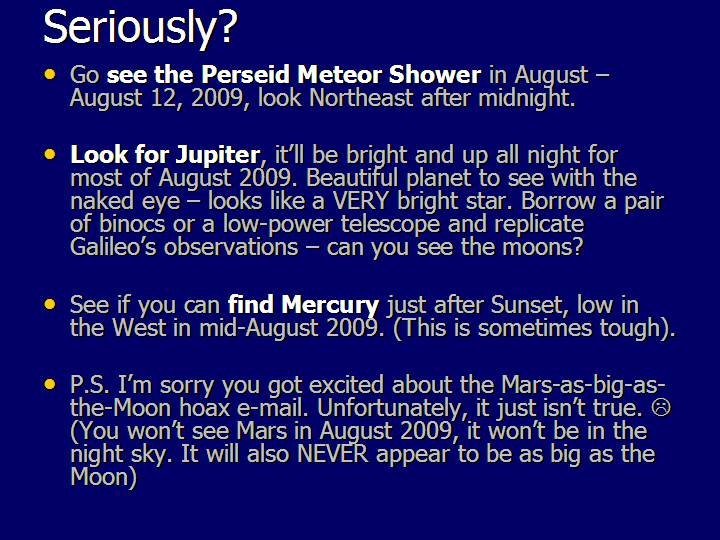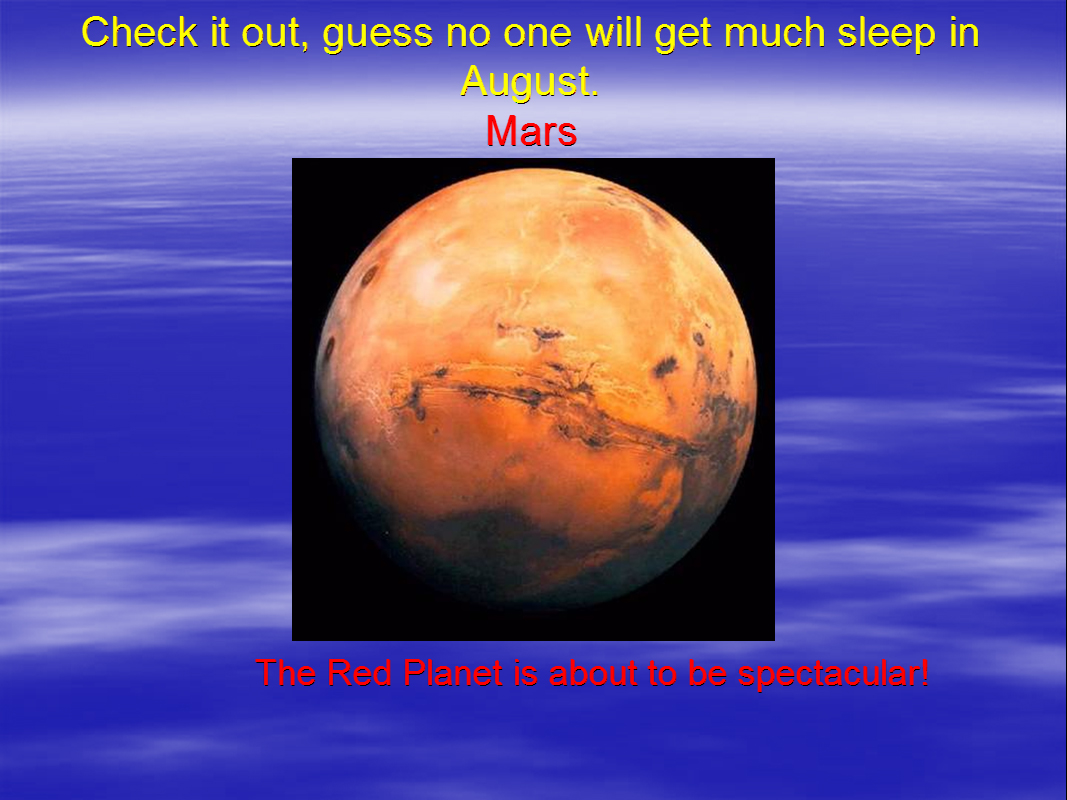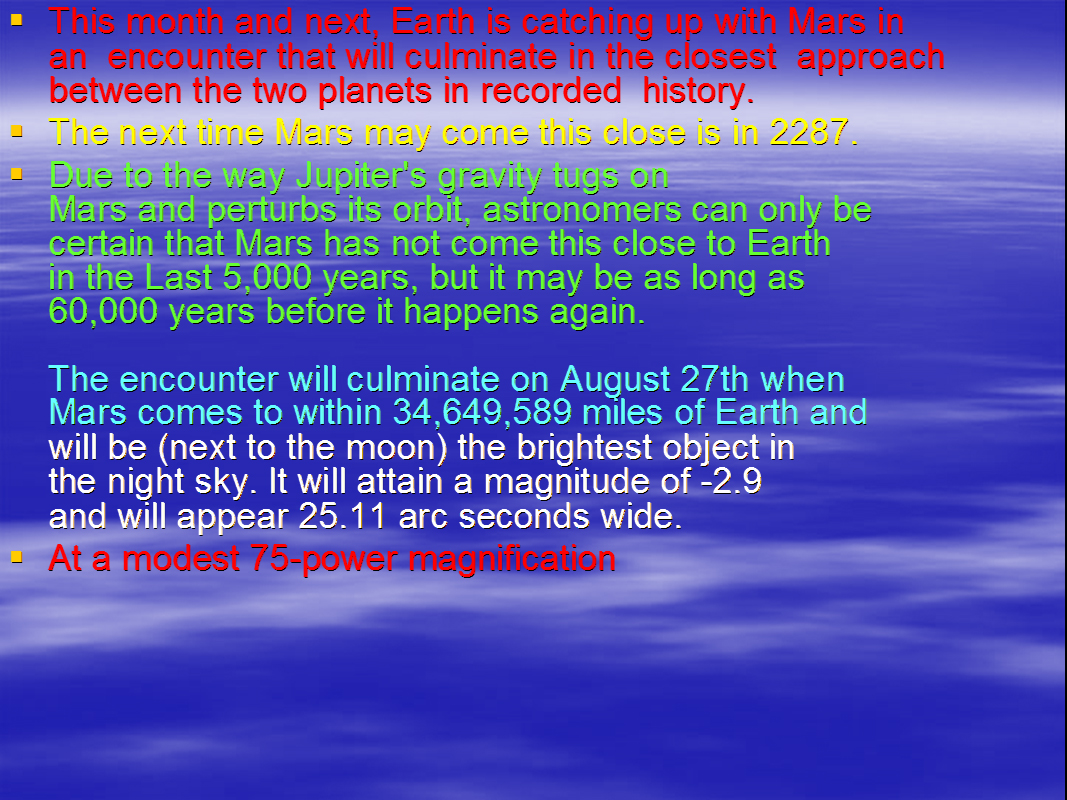 A Puzzle and Two Carnivals
A Puzzle and Two Carnivals
Sunday mornings I enjoy playing the NPR’s puzzler with my family. I thought you might enjoy a puzzle/mindgame too.
It was late one December, and I was out for a walk with my family. The full moon was rising. It was rising almost due Northeast. Why?
This puzzle helped me solidify my understanding of the celestial sphere, so if you already completely understand the celestial sphere it might not be much of a puzzle – but if you’re still learning about it, figuring out this puzzle could be a turning point for you.
I’ll leave moderated comments on for this post: if you leave the answer I won’t approve the comment, but I’ll e-mail you a reply. You are welcome to leave further questions in the comments as well, but hints will only come to you via e-mail, I will not post more hints here.
Also, there are two Carnivals of Space for you to check out:
109, hosted by Discovery Space
![]()
~ A l i c e !
 July-August Sky, 2009
July-August Sky, 2009
Notable Sky Objects
JUPITER
Jupiter will be highly visible late at night, rising not long after sunset in July, and high overhead all night long through the end of August. It will be rising in the Southeast, near the constellation Capricorn.
MERCURY and SATURN
Technically they’ll be in the sky, but they aren’t up for long after sunset, so it will probably be too light to see them this month.
MARS and VENUS
Look towards the constellation Taurus to see Venus rising just after Mars around 3 in the morning in July. In late August, Mars will be rising around midnight in the constellation Gemini, and Venus will still be rising around 2 or 3am in the constellation of Cancer.
EVENTS
July 23- August 22 (peak August 12) – Perseid Meteor Shower, best viewed after midnight.
August 14 – Jupiter at opposition (the Mars Hoax e-mail says Mars will be at opposition in August – it won’t, but you will be able to see Jupiter at opposition instead!)
New Constellations
AQUILA – The Eagle
SCIENCE: Altair is the BEST star in the whole sky.
MYTH: Tanabata: there are versions of this myth all over Asia, all slightly different, but all telling the same basic story. This is one of the Japanese versions. Kengyuu (Altair) is a cowherder boy and he is in love with Orihime (Vega) the weaver princess. They are so in love that they forget to do their chores, and the Emperor decides to punish them. He places them in the sky on opposite sides of Amanogawa, the River of Heaven (the Milky Way) so they cannot meet. The magpies take pity on them, and one day out of the year, on the seventh day of the seventh lunar month (August 26th, 2009), they build a bridge over the Milky Way so the lovers can be together. Unfortunately, if it is raining or cloudy, the magpies are not able to build the bridge.
ANDROMEDA – The Princess
SCIENCE: M31- The Andromeda Galaxy is visible to the naked eye, and better through a telescope.
MYTH: Saudi Arabians called Andromeda “the sea lion”. To the Phoenicians, the whole part of the sky where Andromeda is seen as a threshing floor, and the constellation is a grain thresher working
PERSEUS – Perseus
SCIENCE: The Perseid Meteor shower appears to radiate out of the constellation Perseus. The point meteors all appear to originate is called the “radiant.”
MYTH: For the ancient Chinese, the right side of the constellation Perseus is the Mausoleum. The star just inside the right-hand curl is Jishi – the Heap of Corpses.
PEGASUS – The Flying Horse
SCIENCE: The star at the tip of the horse’s head is called Enif, which means “nose.”
MYTH: The two northernmost stars in the Great Square of Pegasus (α And, and γ Peg: the star attached to Andromeda, and the star next to it that is part of the horse’s back) are the “Encampment” in Chinese mythology. There are three pairs of stars scattered near this asterism which are Ligong or “Resting Places” for the Emperor.
CAPRICORNUS – The Sea Goat
SCIENCE: Jupiter is right beside Capricornus this month.
MYTH: Part of Capricornus along with parts of Pisces and Aquarius make the “Line of Ramparts” in ancient Chinese mythology – a line of fortresses built by the celestial army. Since I can’t read Chinese, I can’t tell you exactly which stars these are, but check the Chinese Starmap.
“Tiny” Guys
Going for the Gold? Here’re this month’s itty-bittys.
CANES VENATICI – The Hunting Dogs
COMA BERENICES – Berenice’s Hair
SERPENS – The Serpent
LIBRA – The Scales
SCUTUM – The Shield
VULPECULA – The Fox
SAGGITA – The Arrow
EQUULEUS – The Horse
LACERTA – The Lizard
TRIANGULUM – The Triangle
LEO MINOR – The Small Lion (Between the Big Dipper and Leo)
CAMELOPARDALIS– The Giraffe
LYNX – The Lynx
Returning Constellations
DELPHINUS – The Dolphin
LYRA – The Lyre
CYGNUS – The Swan
SCORPIUS – The Scorpion
BOÖTES – The Herdsman
HERCULES – Hercules
CORONA BOREALIS – The Northern Crown
CEPHEUS – King Cepheus
DRACO – The Dragon
URSA MAJOR – The Great Bear
URSA MINOR – The Little Bear
CASSIOPEIA – The Queen
Where’d I Get My Info?
My memory, and Zeta Strickland
CHAN Ki-hung, Chinese Ancient Starmap, 2007
![]()
~ A l i c e !
 Two Carnivals (107 and 108)
Two Carnivals (107 and 108)
The Solstice Edition of the Carnival of Space (#108) is up at Starts With a Bang, and I’m the first linked article. Wow!
And don’t miss Edition #107 over at Innumerable Worlds.
![]()
~ A l i c e !
 Solstice Park, West Seattle
Solstice Park, West Seattle
The solstice is on its way! Although there may be celebrations and fun all over Seattle, there is at least one place where you can actually measure the astronomical significance of the longest day of the year: Solstice Park in West Seattle.
You’ve never heard of Solstice Park?
It’s been there since July 2005 – across the street from Lincoln Park, but I have to admit, I only just visited for the first time on Thursday. I loved it. At the top of the hill are stonework and earthworks aligned for sunset on the winter solstice, the summer solstice, and the equinoxes.
Credit: Jason Gift Enevoldsen
Sunset on June 11, 2009
As you can see, during this sunset the Sun isn’t setting quite perfectly above the summer solstice marker, and that’s because the photo was taken ten days before the solstice.
How to get there
Solstice Park is at 7400 Fauntleroy Way SW in Seattle. It used to be called “Lincoln Park Annex” and it still has six tennis courts right beside Fauntleroy, so that should help you find it. There are about 13 parking spaces on the south side of the park, and one handicapped spot at the end of a dead-end street near the top of the park.
Once you’re in the park there are trails that lead up to the overlook: you’ll walk past the tennis courts, through the P-Patch and continue on up the hill. When the trail ends go five more feet to enter the stonework circle and get the best views of sunset.
Stargazing
As of June 2009, the park is open from 4am to 11:30pm, giving you plenty of time for stargazing, unlike many city parks. If you’re looking for dark skies within the Seattle city limits, this is one of the better public places I’ve been to. The trails are unlit, and as long as you stay behind the middle of the overlook, the tennis court lights are shielded from view.
You have an almost perfect western horizon from south southwest to north northwest. The eastern horizon is blocked to about 35 degrees, but that helps cut out the light pollution from Seattle proper.
Want More?
Stop by Pacific Science Center and take a look at our sundial.
Where’d I Get My Info?
Solstice Park Official Website
A review by Nerd’s Eye View
![]()
~ A l i c e !
 Animal Astronomy
Animal Astronomy
by Guest Writer Sophie Arlow
Many people assume that astronomy is solely a human endeavor. After all, we have named constellations, created telescopes, and even landed on the Moon. However, humans are not the only species to use astronomy – from the Moon and stars to magnetic fields, animals also use information from the earth and skies.
The Mystery of Magnetite
What do salmon, dolphins, sea turtles, and whales have in common? These animals share much more than an underwater habitat – all are believed to use a mineral called magnetite to assist in navigation and migration. Magnetite is a special type of iron oxide which, as you might have guessed, is magnetic! Early humans used naturally-occurring deposits of magnetite, called lodestones, as primitive compasses.
Some specialized types of aquatic bacteria contain magnetite, which scientists hypothesize allows them to tell up from down. When exposed to a strong magnetic field, these bacteria all align perfectly, like miniature compass needles. On a larger scale, whales, dolphins, and salmon use magnetite to navigate deep below the water’s surface, where landmarks and visual cues like the sun and stars are not visible.
Expert Nautical Navigators
A serious contender for the title of most skilled animal navigator is the loggerhead sea turtle. Loggerhead hatchlings, only two inches long, emerge from their eggs, dig themselves out of the ground, and, with no help from their parents or other turtles, enter the ocean to begin their spectacular journey. Over a period of several years, loggerhead turtles travel more than 9,000 miles, spanning entire oceans before returning home to coastal regions in North America.

Loggerhead turtles travel over 9,000 miles in the Atlantic Ocean, guided by the Earth’s magnetic field. Credit: UNC Biology
How do hatchlings, never having seen the ocean before, maintain their headings across a vast expanse of often-featureless ocean? As hatchlings reach the water, they begin swimming directly into ocean waves until they are several miles from shore. At this point, hatchlings must use a new navigation method: orienting themselves using the Earth’s magnetic field. It also seems that they have a built-in magnetic map that guides them throughout their migration and allows them to return to the exact location where they hatched to lay their eggs.
How is this amazing feat possible? Scientists aren’t entirely sure. However, they do know that sea turtles’ brains contain tiny crystals of magnetite, which may allow them to sense the direction of the Earth’s magnetic field. This could enable them to find their way across thousands of miles of ocean and return to their birthplace decades later.
Moon Phases Trigger Coral Blooms
The Moon also influences various animals – including those in the sea! Coral reefs (made of huge colonies of coral – a tiny invertebrate animal closely related to a sea anemone) usually spawn once a year. For such a rare event, the coral polyps need to synchronize exactly when they release their gametes.
One trigger that helps them stay in synch is the phase of the Moon. One coral reef in the Caribbean spawns every year on the eighth day after the full Moon in August. That’s pretty specific. Other coral reefs are triggered by different Moon phases, but water temperature, currents, and tides also influence exactly when the coral bloom happens.
Sources
Magnetic Bacteria
The Innovations Report
Sea Turtle Navigation
PBS – NOVA
University of North Carolina Sea Turtle Research
National Geographic Today – Animal Migration
Coral Blooms
http://tinyurl.com/CoralBlooms
 Mars as Big as the Moon 09 #2
Mars as Big as the Moon 09 #2
Okay, I couldn’t resist. For all of you out there who have also been trying to educate folks about the Mars Hoax for years, I’ve created a brief respite.
As you know, this year’s version is going around as a PowerPoint. Once you’ve seen the hoax PowerPoint, you might enjoy my … “corrected” version. If you’re squeamish about random .pps files from the internet, I’ve attached still .jpgs here, but they’re not as cool – there aren’t any annoying animations to click through. The effect just isn’t the same. Enjoy!
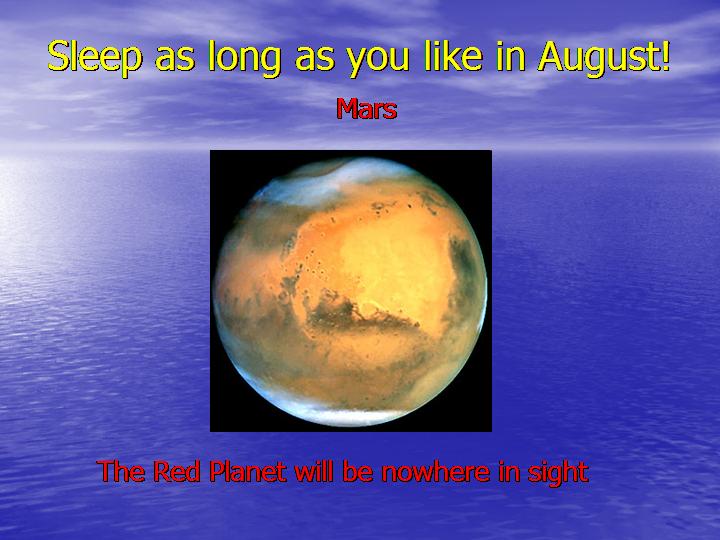
Fixed PPT Slide 1 (well, actually, Mars rises around 2 or 3am, but it starts to get light not that long after that so it might as well be nowhere in sight!)
This really doesn’t follow my rules when it comes to talking to people about the Mars hoax. Mainly it doesn’t let you down easy, and it doesn’t validate the excitement generated by the e-mails. I just made it for fun, and mostly for those who already know.
![]()
~ A l i c e !
 Mars as Big as the Moon (2009 edition) – Still Not True
Mars as Big as the Moon (2009 edition) – Still Not True
It’s back, and it’s more compelling than ever this year. My best post is last year’s. I have also made a corrected version of the e-mail that’s going around in the next post.
- First off: Mars will NOT be as big as the Moon this August (or any August).
- Secondly: Wouldn’t it be cool if it was? Well – it would look cool, but I’d be concerned about the gravitational effects on the Earth.
- Thirdly: Would you like something cool to look for this August instead? Something real? How about the Perseid Meteor Shower? It peaks on August 12th, after midnight. Look Northeast. You can make as many wishes as you like on all those “shooting stars” – you could even wish for the Mars Hoax to come true, if you like.
- Lastly: If you’re bent on seeing Mars, wait until December 2009, and you’ll see it rising in the East mid-evening. It will look like a bright-ish slightly-orange star.
Here are some quickie details:
- Mars is at opposition with Earth (as close as we get) every 26 months.
- This hoax has been going around every August since 2003.
Curious about how that opposition slips against Earth years? Here’s a short overview courtesy of the Students of Exploration and Development of Space.
- In 2003 Mars was at opposition in August, and it WAS close, from an astronomical point of view. It wasn’t actually all that exciting for the average viewer.
- In 2004 Mars was not at opposition.
- In 2005 Mars was at opposition in early November.
- In 2006 Mars was not at opposition.
- In 2007 Mars was at opposition in late December.
- In 2008 Mars was not at opposition.
- In 2009 Mars will not be at opposition (this one slips to January 2010).
- In 2010 Mars will be at opposition in January.
Mars Hoax ’09
This year the e-mail is going around as a PowerPoint attachment, complete with all the PowerPoint bells and whistles you could ever wish to avoid.
This is the PowerPoint file if you really want to see it. I’m not sure I’d trust it to be virus-free if I were you, but I did scan it for viruses, and didn’t find anything: MARS.pps. If you’d rather not risk it – screen-shots of the slides without their animated glory follow.
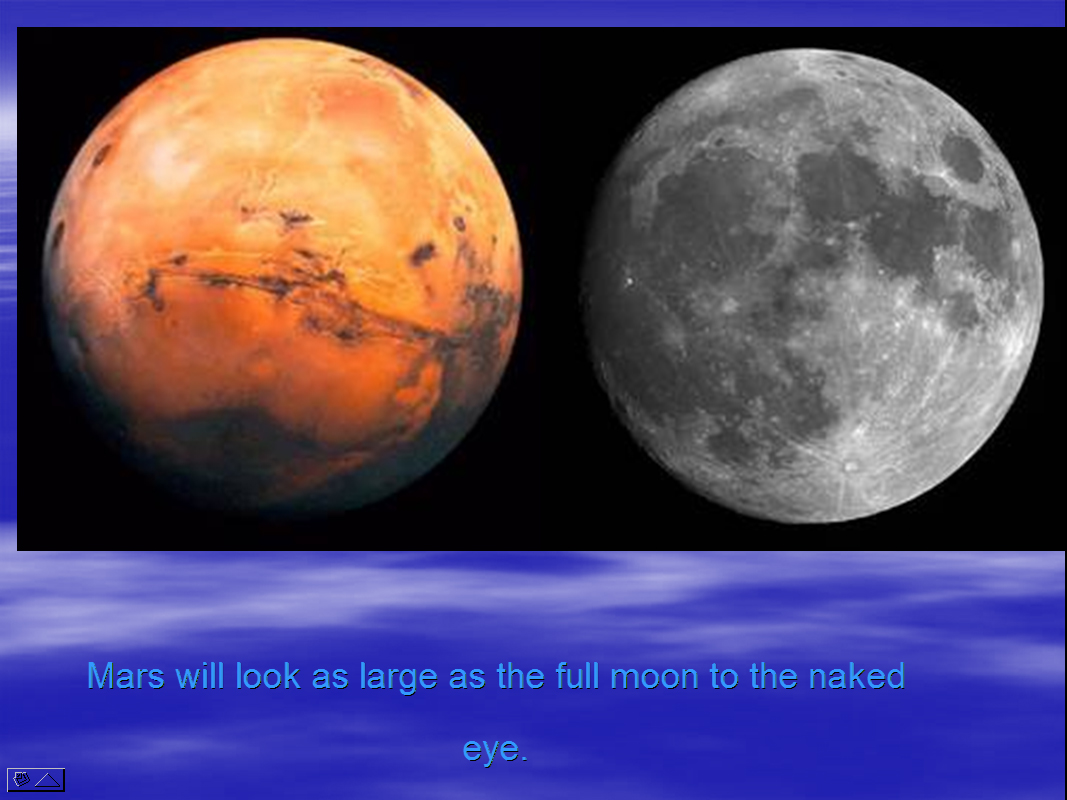
Mars Hoax PowerPoint 2009 Page 3
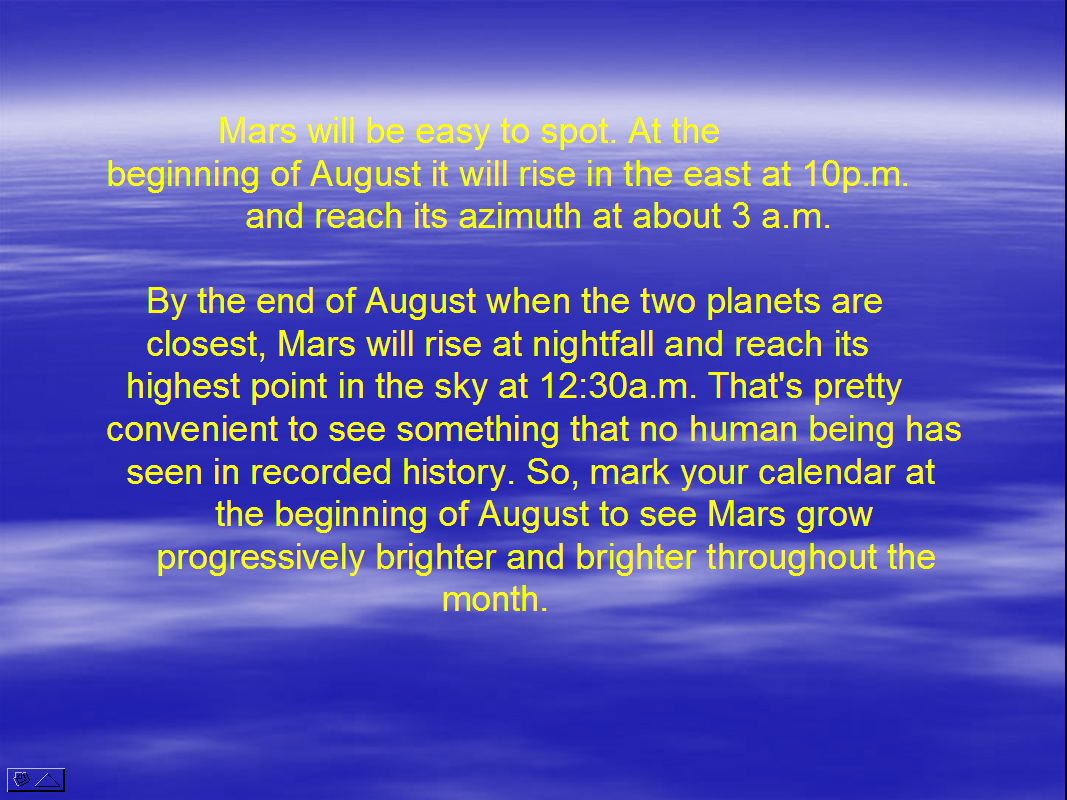
Mars Hoax PowerPoint 2009 Page 4

Mars Hoax PowerPoint 2009 Page 5
Anyway, more info on the history of this hoax is here.
- My first post in 2007
- My previous post in 2008 – this one includes some tips on explaining this to your friends and family when they send you this e-mail.
And some further links from other people:
![]()
~ A l i c e !
 A Few Good Links
A Few Good Links
Phil Plait, the Bad Astronomer, is having an astrophotography contest over at his blog. It is sponsored by Discover Magazine and Celestron. It should be fun, and there are good prizes!
also –
Carnival of Space #103 – over at ChandraBlog has lots of good Hubble links.
Carnival of Space #104 – at Mang’s Bat Page with some cool info on planes and rockets, as well as some great photos.
and
Carnival of Space #105 – hosted by Space Disco also has photos of a number of the featured bloggers! Also, interesting articles and an e-mail with very strange title.
I’m not in any of them, but I will be soon, and check out what others are saying while I’m quiet.
![]()
~ A l i c e !
 AstroInfo is One Year Old!
AstroInfo is One Year Old!
Well how about that, Alice’s AstroInfo has been live on the internet for a whole year! How exciting!
Time for a brief history lesson, and then we’ll get to the cake.
Remember?
AstroInfo didn’t begin as a blog. A few years ago, while I was still in school, Steve White wrote several one-page papers for the planetarians of the Pacific Science Center to help them be more on top of some of the cool current goings-on Out There in space. These pages were lovingly referred to as “Fornax Facts.” (or was it “Fornax’s Facts”? I can’t remember). You see, planetarians at Pacific Science Center have code-names that we usually choose for ourselves. I happen to be called Altair, Steve is Fornax, Holly is Amalthea … etc. Well, Steve got an awesome full-time job teaching Calculus (he still stops by now and then to do some shows of his own), and the job of answering staff questions came to me.
Soon thereafter the IAU made their epic decision regarding Pluto. Most people were confused, or they understood it, but were having trouble making the explanation straightforward enough to include in the limited time we have in a planetarium show. So I wrote the first AstroInfo though I hadn’t quite named it that yet (I’m sorry, it looks like the whole article didn’t come through the transfer, I’ll work on fixing that). That article came out on August 25th, 2006.
Well, almost two years later I had amassed quite a few AstroInfos, and in addition to e-mailing them out to staff and other interested parties I decided to put them up on the internet for anyone who might be interested. Phil Plait and Pamela Gay were hosting a workshop at the 2007 Astronomical Society of the Pacific/American Astronomical Society meeting on astronomy education in cyberspace. They convinced me that Facebook was not an evil, privacy-invading organization, that it could indeed be (carefully) used as a tool, and they suggested WordPress as a good place to start a blog.
Well, I’ve come quite a way: AstroInfo is now hosted on its own site, running WordPress, and I’m on Twitter and Facebook.
I promised you cake
You already know that I like recipes, so here’s a good one. The measurements are American and Fahrenheit. I apologize to those of you who live elsewhere. To make up for this, the cake is Milk-, Egg-, Soy- , Peanut-, and Nut-free (M,E,S,P,N in Food Allergy and Anaphylaxis Network speak).
Ugly Cake
via my friend Corinne Cooley
- 1 ½ Cup Flour
- 1/3 Cup Carob or Flour (or cocoa powder)
- 1 Tsp Baking soda
- ½ Tsp Salt
- 1 Cup Sugar
- 1 ¼ Cup Water
- ¼ Cup Canola Oil
- 2 Tsp Vanilla
- 2 Tbsp Vinegar
Directions:
Mix dry ingredients in 8in circle pan or 9x9in square pan.
Mix wet ingredients. Stir into dry ingredients.
Bake for 45 minutes at 350°F
Prep time: 5 minutes
Bake time: 45 minutes
Notes:
This is the world’s easiest and most flexible cake recipe. Double it. Triple it. Make it into muffins. Top it with brown frosting and as many colors of sprinkles as you can find (this is where the name “Ugly” cake comes from).
![]()
~ A l i c e !
 Carnival of Space (#101, #102)
Carnival of Space (#101, #102)
Oops, I have some catching up to do:
Go see Carnival of Space #101 at Robot Explorers
and
Carnival of Space #102 – at The Spacewriter’s Ramblings
![]()
~ A l i c e !


